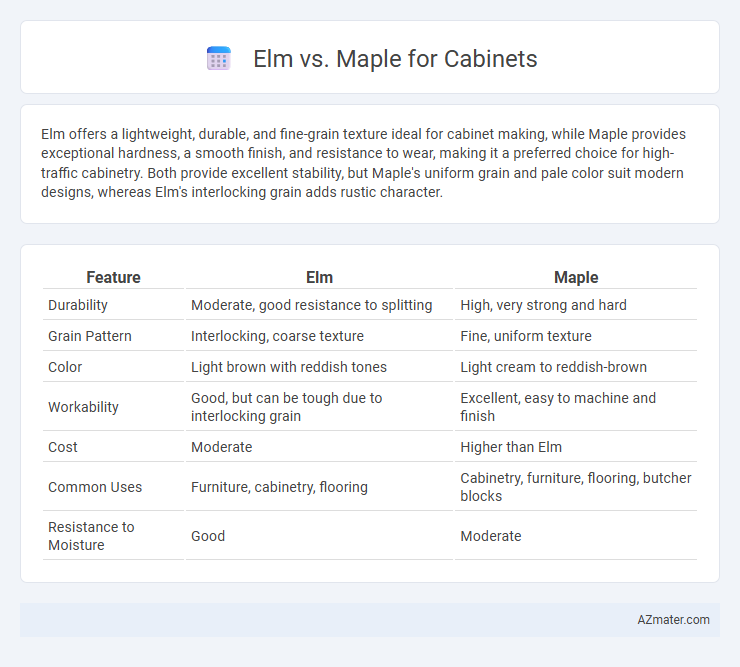Elm offers a lightweight, durable, and fine-grain texture ideal for cabinet making, while Maple provides exceptional hardness, a smooth finish, and resistance to wear, making it a preferred choice for high-traffic cabinetry. Both provide excellent stability, but Maple's uniform grain and pale color suit modern designs, whereas Elm's interlocking grain adds rustic character.
Table of Comparison
| Feature | Elm | Maple |
|---|---|---|
| Durability | Moderate, good resistance to splitting | High, very strong and hard |
| Grain Pattern | Interlocking, coarse texture | Fine, uniform texture |
| Color | Light brown with reddish tones | Light cream to reddish-brown |
| Workability | Good, but can be tough due to interlocking grain | Excellent, easy to machine and finish |
| Cost | Moderate | Higher than Elm |
| Common Uses | Furniture, cabinetry, flooring | Cabinetry, furniture, flooring, butcher blocks |
| Resistance to Moisture | Good | Moderate |
Introduction: Elm vs Maple Cabinets
Elm and maple cabinets offer distinct characteristics that influence their selection in cabinetry. Elm wood is valued for its unique grain patterns, natural durability, and warm reddish-brown tones, making it ideal for rustic and traditional designs. Maple cabinets feature a smooth, fine grain with a lighter color palette, known for strength and resistance to wear, fitting seamlessly into contemporary and classic kitchen styles.
Overview of Elm Wood for Cabinets
Elm wood for cabinets offers a unique combination of durability and attractive grain patterns, making it a popular choice in woodworking. Known for its interlocking grain, elm resists splitting and provides excellent strength, ideal for cabinet construction. Its warm tones and natural luster contribute to a rustic yet elegant cabinet finish that ages well over time.
Overview of Maple Wood for Cabinets
Maple wood is highly prized for cabinetry due to its durability, fine grain, and smooth texture, making it ideal for both traditional and modern designs. Its hardness allows it to resist dents and scratches, ensuring long-lasting cabinets that maintain a polished appearance. The natural light color of maple can be easily stained or painted, offering versatile aesthetic options for various kitchen and bathroom styles.
Appearance and Grain Differences
Elm wood features a distinctive interlocking grain with irregular patterns, often exhibiting a wavy or tiger-stripe appearance, providing a rustic and textured aesthetic ideal for cabin-style furniture. Maple, by contrast, boasts a fine, uniform grain that is smooth and consistent, highlighting a light, clean appearance with subtle grain variations that suit modern or minimalist cabinetry. The choice between elm and maple hinges on desired visual impact: elm offers character and natural complexity, while maple provides simplicity and elegance.
Strength and Durability Comparison
Elm wood offers exceptional strength and resistance to splitting due to its interlocking grain, making it highly durable for cabinet construction. Maple, known for its hardness and fine, uniform texture, provides superior scratch resistance and long-lasting durability in high-use cabinetry. While elm excels in impact resistance, maple outperforms in wear resistance and maintains structural integrity over extended periods.
Cost: Elm vs Maple Cabinets
Elm cabinets typically cost less than maple cabinets due to the faster growth rate and greater availability of elm wood. Maple cabinets offer higher durability and a finer grain, which can increase the price by 20-30% compared to elm. Choosing between elm and maple cabinets depends on budget constraints and preferences for wood hardness and aesthetic quality.
Workability and Finishing Qualities
Elm offers excellent workability due to its interlocking grain, providing good strength and resistance to splitting, which is ideal for intricate cabinet details, while Maple's fine, uniform texture allows for smooth machining and sanding, ensuring precise joints and surfaces. Maple finishes exceptionally well, taking stains and paints evenly to highlight its natural hardness and sleek appearance, whereas Elm's finishing qualities tend to emphasize its distinctive grain patterns but may require more preparation to achieve a smooth surface. For cabinet making, Maple is often preferred for a sleek, modern look with durable finishing, while Elm suits rustic styles where workability and natural grain character are prioritized.
Maintenance and Longevity
Elm wood offers high durability and natural resistance to moisture, reducing maintenance needs for cabinets over time. Maple cabinets are prized for their hardness and fine grain, requiring regular sealing to maintain longevity and prevent wear. Both woods provide strong structural integrity, but elm generally demands less upkeep compared to maple for long-term cabinet performance.
Environmental Sustainability
Elm wood offers a sustainable choice for cabinet making due to its rapid growth rate and ability to thrive in diverse climates, reducing the need for extensive resource input. Maple, while denser and more durable, often requires longer harvesting periods, potentially leading to greater environmental impact if not sourced from certified plantations. Choosing responsibly sourced Elm cabinets supports reduced deforestation and lower carbon footprints compared to traditional Maple alternatives.
Which is Better for Cabinets: Elm or Maple?
Maple is generally preferred for cabinets due to its dense, fine grain and exceptional durability, making it highly resistant to dents and scratches. Elm, while attractive with its unique, interlocking grain patterns, is softer and more prone to wear over time compared to maple. For high-traffic kitchen or bathroom cabinets requiring long-lasting strength and a smooth finish, maple is typically the better choice.

Infographic: Elm vs Maple for Cabinet
 azmater.com
azmater.com